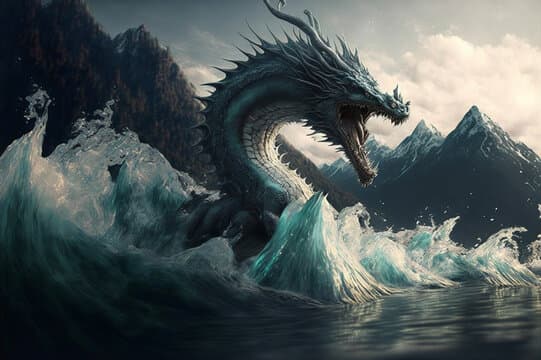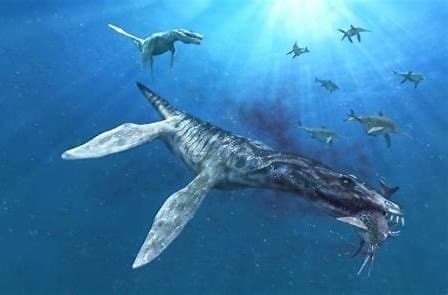Legends of Sea Serpents: Stories of sea monsters pursuing ships and vessels have long been a part of maritime folklore. Terrifying creatures in the uncharted regions of the ocean patiently await their next meal for generations.
History and Legends of Sea Serpents
Their roots are found in historical and mythological literature. For example, the Old Testament describes a fight between God and a sea monster called Rahab, also known as Leviathan. Even ancient Babylonian writings describe a battle between their god Marduk and a multiheaded serpent known as Tiamat. An old Syrian Canaanite text also describes a fight between the god Baal and the monster Leviathan.
Top 10 Largest Cruise Ships in the World: A Look at the Growing Market
Jūrmungandr, also known as “Miðgarðsormr,” is a long sea snake in Norse mythology. Sailors who believed it was an island chain lost their lives, even though it encircled the entire planet. According to Japanese mythology, Yamata no Orochi is an eight-headed serpent with glowing red eyes.
Thus, the scary legends and secrets of the water have become stories of marine monsters, such as enormous squids, sea dragons, reptile monsters, multi-armed beasts, and tales of sea serpents. Additionally, the majority of early maps warned mariners of potential hazards at sea, and uncharted regions of the ocean were always highlighted with a warning such as “here there be dragons.”
Out of all these mythical creatures, the sea snake is particularly fascinating and terrifying, and it is a part of many maritime civilizations around the world. The sea snake is mentioned in several mythologies, including Hebrew, Mesopotamian, and Greek. European sea snake legends have their origins in mythology and stories from Scandinavia. The sea serpents have been portrayed as slithering through the deep waters and coiling around vessels, killing seafarers—a marine creature that our medieval forefathers spoke of on multiple occasions.
The Sightings of Sea Serpents

Marine creatures have been reported for hundreds of years, and some of these reports have surfaced recently. Both coastal residents and seafarers have reported seeing reptile sea monsters on several occasions. There are certain commonalities among the accounts of the sea snake that individuals have seen, even though they differ somewhat.
The following is a summary of some of the more well-known reports of sea serpent sightings and existence:
There is a good deal of evidence in Scandinavian folklore of sea monsters circling the high seas. The Swedish monk Olaus Magnus wrote Carta Marina in the 1500s about the existence of marine monsters.
The first American sea snake, thereafter dubbed “Gloucester’s Sea Serpent,” was first observed in 1639 off the coast of New England, close to Cape Ann, Massachusetts. The sailors came found a snake that “lay quailed up like a cable upon the rock at Cape Ann,” according to John Josselyn, who wrote about this experience in An Account of Two Voyages to New England in 1641. Another sighting of a 27-meter-long serpent was reported in the vicinity of Lynn, Massachusetts, three years later.
Hans Egede, Greenland’s national saint, described a sea snake in the eighteenth century. He claimed that on July 6, 1734, the crew of the ship sailing along the shore of Greenland witnessed an awful being they had never seen before. The creature had a small head and enormous fins, making it longer than their ship.
During a trip to Saint Helena in August 1848, the Royal Navy’s HMS Daedalus crew witnessed another renowned sighting of a sea snake. Some people called it a huge squid; others called it an elephant seal with a snake-like head above the water.
Q-Max Ships: Qatar Gas Consortium’s Largest LNG Carriers with Unique Design
Throughout the early 1900s, newspapers and news articles frequently featured this well-known sea serpent, also known as Cadborosaurus willis or Caddy. The monster was allegedly given the moniker after being frequently observed in British Columbia’s Cadboro Bay.
In 1997, a carcass was discovered in the fishing net of the Japanese-built fishing vessel Kuiyo Maru, which was cruising the coast of New Zealand. There were rumors that this cadaver belonged to a plesiosaurus, an extinct sea animal.
According to biologist Andrew Hebda of the Nova Scotia Museum of Natural History, there have been over 31 reports of these kinds of sea monster sightings in the area in the past 140 years. Hebda claims that the most recent occurrence was documented in 2007.
Regarding the serpent’s length at sea, one of the most prevalent themes throughout all of these sightings is resemblance. Sea monsters may have some truth to the popular belief that they exist due to this similarity.
Is it real?

Although this creature is universally accepted, many people doubt its existence. Some people believe that sea serpents are misidentified and that they do not exist.
Many attempts have been made to ascertain the veracity of these reports of sightings of sea serpents. Some have deduced that those “monster” animals were whales or seals migrating, frequently showing up in places outside of their natural environment. Reports indicate that people have misidentified sea monsters as whales, sharks, squids, and even enormous eels.
This is because every description of the snake seen at sea describes it as having fins for propulsion. Given the enormous breadth of their fins, whales and sharks make senseland animals to mistake for marine monsters.
Most ocean stories color sea serpents because people cannot see them clearly in the waves from a distance. Additionally, based on those tales, news reports, and artworks of those animals, other sightings must have made comparable observations.
Various people have speculated that in old folklore this was an oarfish that sank ships. According to scientists, oarfish can reach lengths of up to 11 meters and swim on the surface like snakes. Furthermore, the myth that oarfish attack ships and devour sailors must have developed due to their harmless nature.
Untold secrets await discovery in the underwater depths, whether sea monsters are real or just hyperactive imaginations. The hypothesis of the sea serpent has also gained traction, giving people around the world something fascinating to think about, much like Sinbad’s seven seas voyage.


